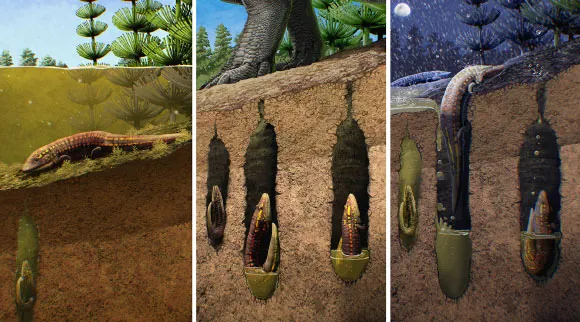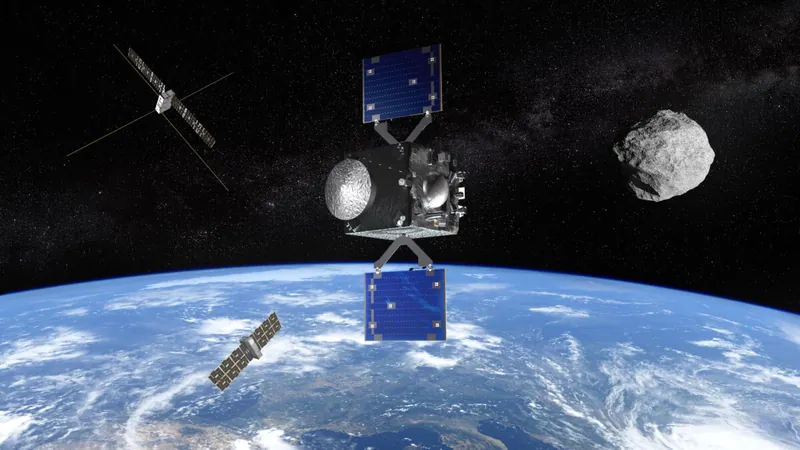
Meet Ninumbeehan dookoodukah: The Triassic Amphibian That Outsmarted Droughts!
2024-11-26
Author: Wei
New Discovery of Ninumbeehan dookoodukah
In a groundbreaking discovery, paleontologists have unveiled a new species of fossil temnospondyl amphibian from the Triassic Jelm Formation in Wyoming, known as Ninumbeehan dookoodukah. This ancient creature, which lived over 231 million years ago during the early Late Triassic epoch, is intriguing not only for its time period but also for its unique adaptations to survive severe seasonal droughts.
Survival Strategy
Researchers uncovered well-preserved skeletal remains of several Ninumbeehan dookoodukah individuals in cylindrical, torpedo-shaped burrows, up to 30 cm (12 inches) in length. These burrows, found in the sediment of what was likely a once-vibrant riverbed, served as temporary shelters for the amphibians during the dry season. “These fossils were discovered alongside their estivation burrows, indicating a remarkable survival strategy,” stated Dr. Cal So, a postdoctoral researcher from the Field Museum.
Impact of Climate
The area where Ninumbeehan dookoodukah thrived was influenced by dramatic seasonal shifts due to the mega-monsoon effects surrounding the supercontinent Pangea. “The rock formations provide data about this ancient climate, showing that the amphibians had to endure extreme dry spells," Dr. So explained.
Exceptional Adaptability
What sets Ninumbeehan dookoodukah apart is its exceptional adaptability. Paleontologists suggest that this species likely spent the rainy months swimming in rivers and took refuge underground when water sources dried up. The anatomical features of its skull, described as scoop-shaped, hint that it may have used its head to dig into the riverbed’s mud, allowing it to access cooler, moist environments beneath the surface, thus enabling them to lower their metabolism and enter a state similar to hibernation for several months.
Significance of Discovery
According to Dr. Jason Pardo, another researcher involved in this study, “Small amphibians are quite rare in the Triassic, making this discovery particularly significant.” The existence of Ninumbeehan dookoodukah provides vital insights into the evolutionary paths amphibians have taken and raises questions about the survival strategies of their modern descendants.
Relevance to Modern Climate Challenges
Interestingly, this ancient amphibian could hold answers for contemporary amphibian species facing climate challenges today. “The remarkable ability of Ninumbeehan dookoodukah to reduce its metabolic rate during dry spells suggests that certain modern amphibians could also adapt to extreme weather patterns,” Dr. Pardo noted. “It’s a flicker of hope in light of the significant threats that climate change poses to amphibian diversity.”
Conclusion
The exciting findings surrounding Ninumbeehan dookoodukah are documented in a recent publication in the *Proceedings of the Royal Society B*, offering a glimpse into the dynamic interactions between ancient climate conditions and amphibian evolution. As climate patterns continue to shift, studying these ancient species may help scientists understand potential future adaptations in modern amphibians.
So what does this mean for the future of amphibians on our planet? Stay tuned, as research continues to unfold on these extraordinary creatures that once roamed the Earth, reminding us of the resilience needed to thrive amidst environmental challenges!



 Brasil (PT)
Brasil (PT)
 Canada (EN)
Canada (EN)
 Chile (ES)
Chile (ES)
 España (ES)
España (ES)
 France (FR)
France (FR)
 Hong Kong (EN)
Hong Kong (EN)
 Italia (IT)
Italia (IT)
 日本 (JA)
日本 (JA)
 Magyarország (HU)
Magyarország (HU)
 Norge (NO)
Norge (NO)
 Polska (PL)
Polska (PL)
 Schweiz (DE)
Schweiz (DE)
 Singapore (EN)
Singapore (EN)
 Sverige (SV)
Sverige (SV)
 Suomi (FI)
Suomi (FI)
 Türkiye (TR)
Türkiye (TR)